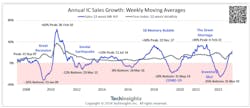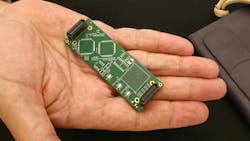What you’ll learn:
- Why details like test and obsolescence need to be handled early.
- How tariffs are related to design for obsolescence.
- Take our poll on your concerns about product availability.
Why is it challenging to use artificial intelligence (AI) to assist in design? Probably because design and implementation of a system or application involves so many different aspects and requirements. Even seasoned professionals find it strenuous. Designers need to consider the actual application first, but they or part of their team need to address:
- Design for test
- Design for manufacturing
- Design for obsolescence
- Design for security
- Design for safety
- Design for availability
- Design for tariffs
I added the last one after hosting the Obsolescence Management Starts at Design webinar, presented by Dan Deisz, Vice President of Design Technology at Rochester Electronics. It’s definitely worth a view—design for obsolescence is directly related to issues related to the massive fluctuating tariffs imposed by President Trump.
Consider the four main categories of semiconductor product obsolescence that Dan brings up:
- Silicon obsolescence or fab process obsolescence
- Package obsolescence
- Tester platform obsolescence
- Revenue targets not being met
I’m not going to delve into the details; watch the webinar instead. What I do want to highlight is that design for obsolescence looks at long-term availability, whereas the latest set of tariffs are potentially short term. The question is whether the fluctuation and use of tariffs will continue in the long term. If so, designers may need to be more aggressive in their designs to address availability issues in addition to all of the other design considerations already mentioned.
Integrated-circuit (IC) availability is also tied into cost, and the semiconductor market in general has been fluctuating over time (Fig. 1). The chart is from 2024, so we’ll have to wait for 2025's version for updated results.
Design for X is Hard Because There’s No Second Source
I started my electrical engineering career when 7400 TTL was the norm. Chip availability was relatively stable and second sourcing of pin-compatible chips was common. Plenty of parts were still single source, but these days unique chips are the norm, making long-term availability an issue. It’s one reason why long-term availability support is crucial for applications such as automotive and avionics. If you’re planning to support products for the long term, then piggybacking on this long-term support is the way to go even if it does limit the parts selection.
These days, modular design at the board or module level provide flexible alternate source options. With computer-on-module (COM) form factors like PICMG’s COM-HPC COM Express, system designers can choose from a variety of solutions. Peripherals standards include Mini-PCI Express, M.2, and the new VITA 93 QMC mezzanine standard (Fig. 2).
Boards and modules will work for larger form factor solutions, but that only applies to some designs. Custom systems and applications that are more compact or rugged solutions often prevent them from being design alternatives, in which case designers may have to resort to different approaches or part choices.
One possible approach at the PCB level is to support alternatives by accommodating different part configurations, using extra space or novel layouts so that components with different configurations can be substituted in the manufacturing process. Though this has been done for storage devices, it tends to be useful for individual components that are hard to obtain or are changing, such as newer configurations that may provide more memory.
With tariffs, issues like availability are just part of the problem. Now one must consider where something is assembled or how it might be delivered to the customer. These tend to be outside the realm of the typical engineer or programmer, but they can impact design decisions.
Adapting to changing requirements and new technology is what engineers, programmers, and designers do. However, it continues to get harder even with the addition of AI to the mix. Or did that just make things harder?
More Tariff Implications
If this article piqued your tariff interest, here are a few other articles on the topic:
- Chemical Industry Wary as Trump Tariffs Take Effect @ Chemical Processing
- ‘This is nuts’: Supply chain expert on tariffs, trucking @ FleetOwner
- Opportunities and Challenges from Tariffs: Production Pulse @ IndustryWeek
- How is the Fluid Power Industry Responding to Tariffs? @ Power & Motion
- Reshoring advocate discusses tariffs, turmoil and timelines @ Plastics Machinery & Manufacturing
- Trump tariffs may already be impacting the offshore oil and gas industry @ Offshore
About the Author
William G. Wong
Senior Content Director - Electronic Design and Microwaves & RF
I am Editor of Electronic Design focusing on embedded, software, and systems. As Senior Content Director, I also manage Microwaves & RF and I work with a great team of editors to provide engineers, programmers, developers and technical managers with interesting and useful articles and videos on a regular basis. Check out our free newsletters to see the latest content.
You can send press releases for new products for possible coverage on the website. I am also interested in receiving contributed articles for publishing on our website. Use our template and send to me along with a signed release form.
Check out my blog, AltEmbedded on Electronic Design, as well as his latest articles on this site that are listed below.
You can visit my social media via these links:
- AltEmbedded on Electronic Design
- Bill Wong on Facebook
- @AltEmbedded on Twitter
- Bill Wong on LinkedIn
I earned a Bachelor of Electrical Engineering at the Georgia Institute of Technology and a Masters in Computer Science from Rutgers University. I still do a bit of programming using everything from C and C++ to Rust and Ada/SPARK. I do a bit of PHP programming for Drupal websites. I have posted a few Drupal modules.
I still get a hand on software and electronic hardware. Some of this can be found on our Kit Close-Up video series. You can also see me on many of our TechXchange Talk videos. I am interested in a range of projects from robotics to artificial intelligence.



